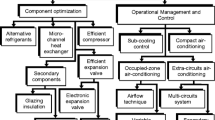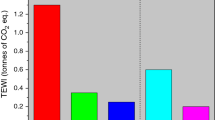Abstract
Vapor-compression refrigeration (VCR) systems are still the most widely used type of automotive air conditioning (A/C) systems in spite of their high energy consumption and negative environmental effects. Although the significant amount of research conducted during the last three decades, the automotive alternative (A/C) systems are yet immature. Despite some remaining constraints only (VCR)-type of A/C systems, powered by electric energy and used in EV’s, have reached the commercialization level. Also thermoelectric A/C systems powered by recovered exhaust energy and used for seat occupant cooling as well as (VCR) A/C systems powered by solar energy, are developed to the extent that they can be commercialized in the near future. Whereas the other alternative systems still suffer from many challenges that make them unable to satisfy the severe requirements of automotive air conditioning. Among those challenges: Large system size and complexity which do not realistically work in the demanding automotive environment, low coefficient of performance (below one for most of them) which prevents them from competing with the conventional (VCR) systems, high initial cost and lack of enough heat to power most of the systems. However alternative A/C systems have the advantage of being eco-friendly. A future development roadmap is presented to overcome the above-mentioned challenges.
Similar content being viewed by others
References
S. A. McEvoy, A brave new world: The environmental and economic impact of autonomous cars, Modern Environmental Science and Engineering, 1 (1) (2015) 1–7.
A. Subiantoro, K. Tiow and U. Stimming, Energy saving measures for automotive air conditioning (AC) systems in the tropics, 15 th International Refrigeration and Air Conditioning Conference, Purdue University (2014).
T. Onoda and T. Gueret, Fuel efficient road vehicle nonengine components: potential savings and policy recommendations, IEA Information Paper, OECD/IEA, October (2007).
M. Bentrcia, M. Alshatewi and H. Omar, Developments of vapor-compression systems for vehicle air-conditioning: A review, Advances in Mechanical Engineering, 9 (8) (2017) 1–15.
D. Quick, Solar-powered air-conditioning for vehicles developed, November 17 (2010).
Y. Lethwala and P. Garg, Development of auxiliary automobile air conditioning system by solar energy, International Research Journal of Engineering and Technology (IRJET), 4 (7) July (2017).
R. de Boera, Thermally operated mobile air conditioning systems, The 3 th Eurepean Workshop-Mobile Air Conditioning, Vehicle Thermal Systems and Auxiliaries, Torino, Italy, November 26-27 (2009).
C. A. Lindgren, Feasibility study of utilizing solar panels to power a vehicle’s onboard air conditioner, Rensselaer Polytechnic Institute, Hartford, CT, December (2012).
P. Lin, Performance evaluation and analysis of EV airconditioning system, The 25th World Battery, Hybrid and Fuel Cell Electric Vehicle Symposium & Exhibition, EVS-25 Shenzhen, China, November 5-9 (2010).
Z. Tian, C. Qian, B. Gu, L. Yang and L. Liu, Electric vehicle air conditioning system performance prediction based on artificial neural network, Applied Thermal Engineering, 89 (2015) 101–114.
Q. Peng and Q. Du, Progress in heat pump air conditioning systems for electric vehicles - A review, Energies, 9 (2016) 240, Doi: 10.3390/en9040240.
Á. G. Miranda, T. S. Chen and C. W. Hong, Feasibility study of a green energy powered thermoelectric chip based air conditioner for electric vehicles, Energy, 59 (2013) 633–641.
M. Linder and K. Kulenovic, An energy-efficient airconditioning system for hydrogen driven cars, International Journal of Hydrogen Energy, 36 (4) (2011) 3215–3221.
I. A. Cachorro, Absorption heat pump for air conditioning driven by fuel cell waste, Energy Technology, Aalborg University (2013).
C. J. Forster, Developments of an air-cycle environmental control system for automotive applications, Tthe faculty of California Polytechnic State University, San Luis Obispo (2009).
M. N. Vandana and R. Shankul, Design of air conditioning system by using air refrigeration cycle for cooling the cabinet of truck, IOSR Journal of Mechanical and Civil Engineering (IOSR-JMCE), 13 (3) Ver. IV (May-Jun) (2016) 19–23.
Z. Zhang, S. Liu and L. Tian, Thermodynamic analysis of air cycle refrigeration system for Chinese train air-conditioning, Systems Engineering Procedia, 1 (2011).
Amirgon Incorporated, Amerigon's climate control seat (TM) (CCS(TM)) system offered as an option on 2006 Cadillac DTS. August 9 (2005), http://www.amerigon.com/.
M. Stancila, Studies on the use of thermoelectric elements for improving thermal comfort in automobile, Cristina-Andreea ENE. (2013).
M. S. Raut and P. V. Walke, Thermoelectric air cooling for cars, International Journal of Engineering Science and Technology, 4 (5) (2012) 2381–2394.
C. Maronde, C. Maranville and E. Gundlach, Automotive thermoelectric HVAC development and demonstration project, National Energy Technology Laboratory United States Department of Energy, CE C-500-2016-017, May (2016).
M. R. Rahamathullah, K. Palani, T. Aridass, S. P. Venkatakrishnan and S. Palani, A review on historical and present developments in ejector systems, International Journal of Engineering Research and Applications, 3 (2) (2013) 10–34.
T. Jaruwongwittaya and G. Chen, Application of two stage ejector cooling system in a bus, Energy Procedia, 14 (2012) 187–197.
Denso, Denso develop world’s first passenger vehicle air conditioning system using an ejector, Kariya, Japan, May 19 (2009).
S. Wang, Motor vehicle air-conditioning utilizing the exhaust gas energy to power an absorption refrigeration cycle, University of Cape Town (1996).
D. T. Shekhar, D. M. Prateek, L. R. Rupesh and A. G. Amol, Cooling of a truck cabin by vapour absorption refrigeration system using engine exhaust, International Journal of Research in Engineering and Technology, 3 (5) (2014) 816–822.
G. Karthik, K. U. Rani and S. S. Likhitha, Development of air conditioning system based on vapor absorption refrigeration cycle for automobiles using exhaust gases with R 134a-DMF, International Journal of Mechanical Engineering and Technology, 5 (7) (2014) 42–50.
A. Shah, A proposed model for utilizing exhaust heat to run automobile air-conditioner, The 2nd Joint International Conference on Sustainable Energy and Environment (SEE 2006), Bangkok, Thailand, 21-23 November (2006).
K. AlQdah, S. Alsaqoor and A. Al-Jarrah, Design and fabrication of auto air conditioner generator utilizing exhaust waste energy from a diesel engine, Int. J. of Thermal & Environmental Engineering, 3 (2) (2011) 87–93.
I. Hilali and M. S. Soylemez, An application of engine exhaust gas driven cooling system in automobile airconditioning system, J. of Thermal Science and Technology, 35 (1) (2015) 27–34.
M. H. Hossen and M. T. Rahman, Implementation of a waste-heat driven vapor absorption-based car air conditioning system, International Conference on Mechanical, Industrial and Energy Engineering, Khulna, Bangladesh, 26-27 December (2014).
B. Multerer and R. L. Burton, Alternative technologies for automobile air conditioning, Air Conditioning and Refrigeration Center, University of Illinois, Mechanical & Industrial Engineering Dept. 1206 West Green Street, Urbana, IL 618 (1991).
M. A. Lambert and B. J. Jones, Automotive adsorption air conditioner powered by exhaust heat. Part 1 conceptual and embodiment design, Proceedings of the Institution of Mechanical Engineers Part D: J. Automobile Engineering, 220 (2006) 959–972.
Z. Yongfang, L. W. Kevin and F. Tiegang, An adsorption air-conditioning system to reduce engine emissions and fuel consumption for heavy-duty vehicles, International Refrigeration and Air Conditioning Conference (2010) http://docs. lib.purdue.edu/iracc/1100.
H. Tiwari and G. V. Parishwad, Adsorption refrigeration system for cabin cooling of trucks, International Journal of Emerging Technology and Advanced Engineering, 2 (10) (2012) 337–342.
L. Z. Zhang, Design and testing of an automobile waste heat adsorption cooling system, Applied Thermal Engineering, 20 (1) (2000) 103–114.
M. G. Dhiraj and M. N. Sanjay, Experimental evaluation of vapour adsorption cooling system powered by axhaust heat of automobile system, International Engineering Research Journal (IERJ), 1 (5) (2015) 204–207.
S. L. Leo, Design, fabricate and performance study of an exhaust heat-driven adsorption air-conditioning system for automobile, Faculty of Engineering, Universiti Malaysia Sarawak (2009).
M. Linder, Automotive cooling systems based on metal hydrides, Institute of Nuclear Technology and Energy systems, University of Stuttgart (2010).
F. Qin, J. Chen, M. Lu, Z. Chen, Y. Zhou and K. Yang, Development of a metal hydride refrigeration system as an exhaust gas-driven automobile air conditioner, Renewable Energy, 32 (12) (2007) 2034–2052.
D. C. Ganger, Alternative technologies for refrigeration and air conditioning applications, Ph.D. Thesis, Mechanical Engineering, Iowa State University Ames, Iowa (1993).
Author information
Authors and Affiliations
Corresponding author
Additional information
Recommended by Associate Editor Chang Yong Park
Mohamed Bentrcia is a Professor of Mechanical Engineering, Qassim University, Qassim, Saudi Arabia. He received his Ph.D. in mechanical engineering from R.P.I. in U.S.A. and his research interest is on thermal systems (air conditioning and other systems).
Rights and permissions
About this article
Cite this article
Bentrcia, M., Alshitawi, M. & Omar, H. Developmens of alternative systems for automotive air conditioning - A review. J Mech Sci Technol 32, 1857–1867 (2018). https://doi.org/10.1007/s12206-018-0342-2
Received:
Revised:
Accepted:
Published:
Issue Date:
DOI: https://doi.org/10.1007/s12206-018-0342-2




